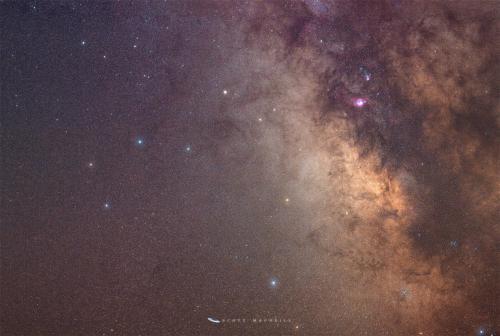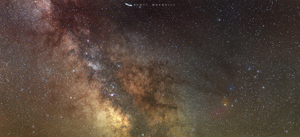Sagittarius, the Archer
The last few months have been an observing bonanza for amateur astronomers and casual stargazers alike. Jupiter returned to a late evening sky, followed by Saturn and then more recently Mars. The local observatories have provided great views of these distant worlds when the skies were clear, and those of us fortunate to own even small to modest sized telescopes have been able to explore this parade of planets from the convenience of our backyards. If you haven’t found the time to observe this planetary “line-up” yet, the opportunity to do so is still possible.
At the beginning of September after sunset if you look towards the west southwest you’ll spot brilliant Venus. Venus will soon disappear as it moves closer to the Sun in our sky and sinks below the horizon. Jupiter will be the bright object up and to the left of Venus. Following a low arc east across the sky you’ll find Saturn, located above the teapot lid of Sagittarius. And finally, if you continue along that arc to the east you’ll have no difficulty finding pumpkin-colored Mars (see last month’s column).
Make Jupiter your observing priority, as he’ll be difficult to view by mid-October, depending on your horizon view. You’ll have a couple of more months to view Saturn, and Mars will be visible through the rest of the year (though this “Red Planet’s” size through a telescope will shrink as the Earth pulls out ahead of Mars in our respective orbits. During Mars’ close encounter with the Earth back on July 31 our two worlds were only 35.8 million miles apart. By December 31 that distance will have grown to 117.1 million miles.
While you may be concentrating on this beautiful display of planets, you can’t help but notice the patch of milky nebulosity stretching across the sky from north to south. It’s our own Milky Way galaxy. And the constellation I wish to introduce you to is Sagittarius.
I can’t believe I have not written specifically about Sagittarius in the past, but I checked my column archives and only found it mentioned in my exploration of the Milky Way.
Sagittarius is an easy constellation to identify, but not in the guise of classical Greek mythology where the star pattern represents a centaur (half-human, half horse) archer, whose poisoned tipped arrow is pointed towards the scorpion’s heart (Antares) in nearby Scorpius. However, today we describe this star pattern as a teapot with the handle to the left and the spout to the right. The Milky Way appears to pour like steam up into the sky from the spout.
After sunset on September 1 look due south about 22 degrees above the horizon to find Sagittarius. Use the accompanying star map to help you identify this star pattern. If you explored Saturn after my column two months ago, then you already should recognize Sagittarius. Saturn is still above and to the right of the teapot’s lid. But this region of sky contains many objects of interest to stargazers. While my columns on observing the planets required one to use a telescope to appreciate their beauty, a pair of 7x35 or 7x50 binoculars will initially suffice to explore the many star cluster and nebulae within this stellar pictogram.
People often forget that binoculars can be used for stargazing. Once you focus a pair on the Sagittarius region you’ll find many intriguing astronomical objects that you will want to explore in greater detail using your own telescope or one at the local observatories.
Following is a short descriptive list of some of those brighter objects. They all have a designation with the prefix of “M”. French astronomer Charles Messier (1730-1817) cataloged them while he was hunting for comets.
There are a few bright open clusters within Sagittarius. Open clusters are groups of stars that formed out of vast dust clouds at the same time. There can be hundreds to a few thousands of stars in these clusters. Because they are only loosely gravitationally bound as a group, over millions of years the cluster will disperse. Four notable open clusters in Sagittarius are: M17, M21, M23 and M24. See the star map for their locations within the constellation. Binoculars will help you find them, but once you do be sure to use a telescope to reveal their beauty.
In addition, there is a bright more compact cluster of stars call M22. It is a globular cluster, a spherical group of 70,000+ stars tightly gravitationally bound. Binoculars will only show it as a diffuse, non-stellar patch. A small telescope will definitely enhance the view. If you could speed up time and watch the stars they would look like bees around a hive, their common center of gravity. There are 150 known globular clusters that orbit the Milky Way galaxy in a halo.
And finally, two exquisite emission nebulae await your discovery in Sagittarius. One is the Lagoon Nebula (M8) and the other one is the Trifid Nebula (M20). Binoculars will easily show them, and a telescope under low magnification will reveal them in the same field of view. These nebulae glow due to the gases being ionized by a nearby hot star. While photographic images show beautiful colors, your eye will see them more as a grayish-green hue. Observing from a dark location will reveal their intricate structure and beauty.
There are many more “deep sky” objects within Sagittarius, but I’ll let you discover some of them yourself.
After you’ve explored Sagittarius and what objects it has to offer, take some time to scan up and down the Milky Way to observe this star rich region of space. You’ll be amazed at all the stars you can see, especially if you take a drive out in the country away from interfering light pollution
Keep in mind that when you are looking at Sagittarius you are looking towards the center of our Milky Way galaxy. While you can’t see it, a super massive black hole called Sagittarius A resides there.
Enjoy the cosmological beauty that city lights obscure by using your binoculars and telescopes to collect starlight, not dust!!
Don’t forget to visit the local observatories to experience the beauty of the heavens.
Good observing.
David A. Huestis
- Author:
- David Huestis
- Entry Date:
- Sep 3, 2018
- Published Under:
- David Huestis's Columns






